In-depth Analysis of Capital Structure and Risk Management of AMP
VerifiedAdded on 2023/06/03
|8
|1537
|500
Report
AI Summary
This report provides a comprehensive analysis of AMP Limited's capital structure and risk management strategies. It begins with an overview of the company, followed by an examination of its current capital structure and weighted average cost of capital (WACC), noting the firm's reliance on equity. The report compares AMP's capital structure with that of the Commonwealth Bank of Australia (CBA) and identifies key financial ratios, suggesting areas for improvement in liquidity and profitability. Additionally, it analyzes the risks identified by the directors and the company's risk management efforts, highlighting instances where risks were not adequately managed. The conclusion summarizes the findings and offers recommendations for enhancing AMP's capital structure and risk management practices.
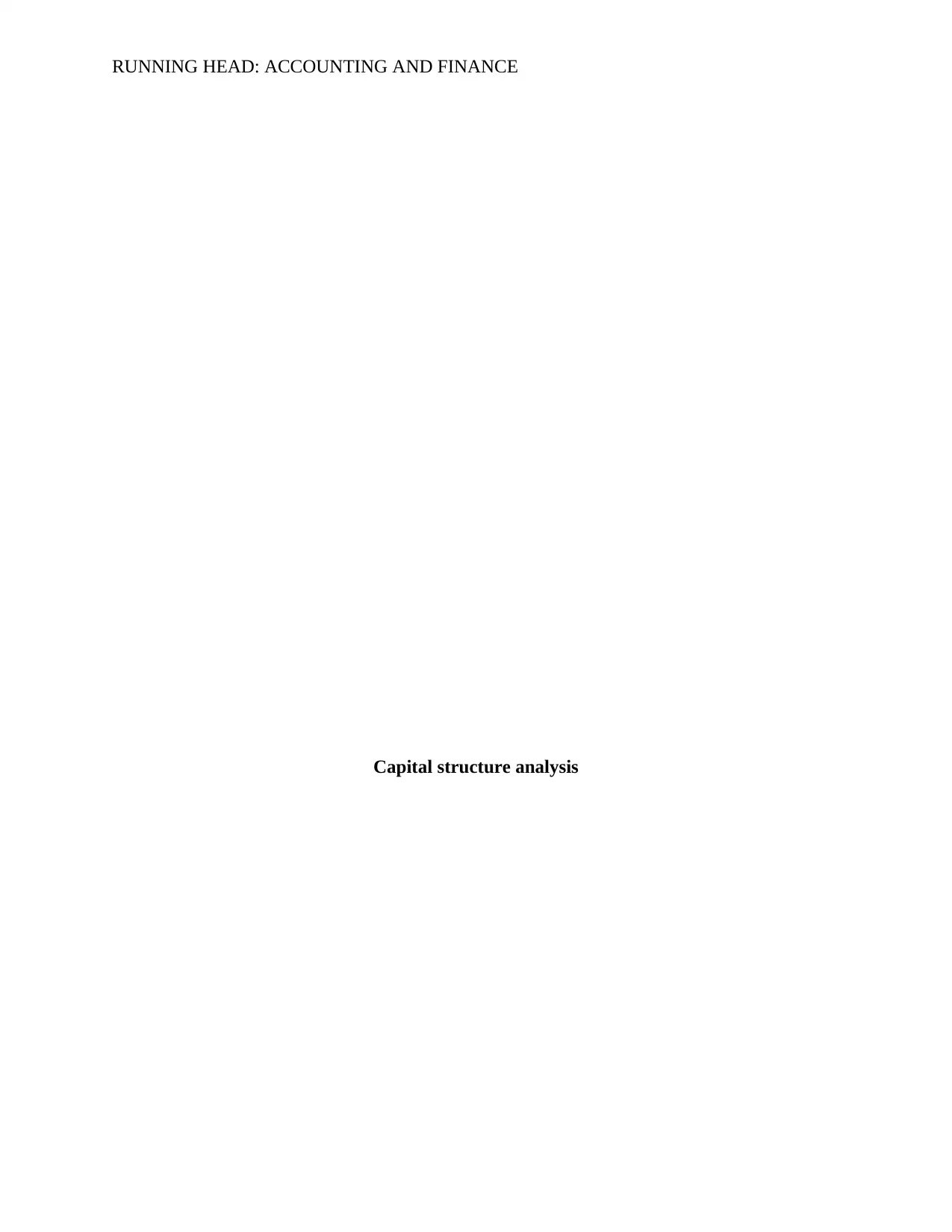
RUNNING HEAD: ACCOUNTING AND FINANCE
Capital structure analysis
Capital structure analysis
Paraphrase This Document
Need a fresh take? Get an instant paraphrase of this document with our AI Paraphraser
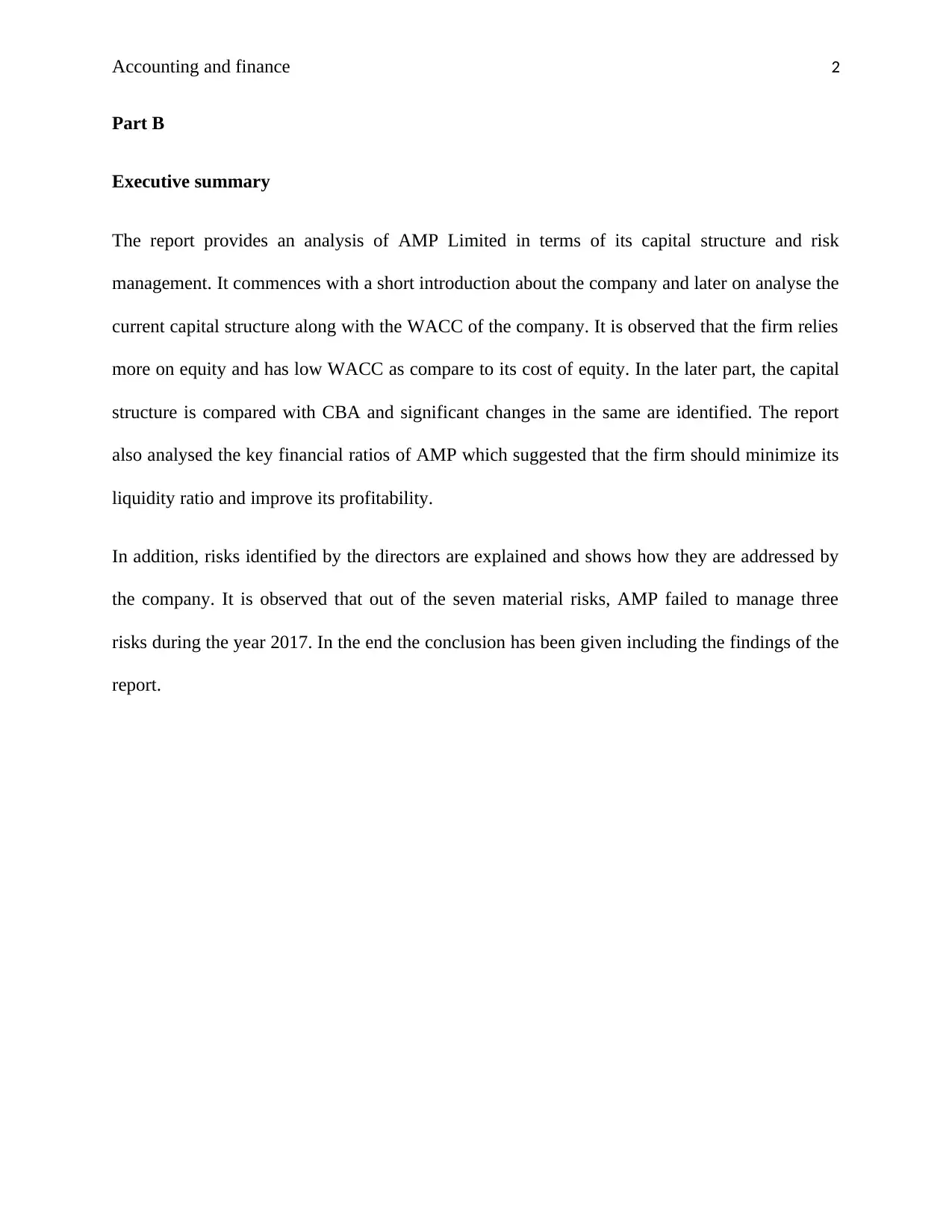
Accounting and finance 2
Part B
Executive summary
The report provides an analysis of AMP Limited in terms of its capital structure and risk
management. It commences with a short introduction about the company and later on analyse the
current capital structure along with the WACC of the company. It is observed that the firm relies
more on equity and has low WACC as compare to its cost of equity. In the later part, the capital
structure is compared with CBA and significant changes in the same are identified. The report
also analysed the key financial ratios of AMP which suggested that the firm should minimize its
liquidity ratio and improve its profitability.
In addition, risks identified by the directors are explained and shows how they are addressed by
the company. It is observed that out of the seven material risks, AMP failed to manage three
risks during the year 2017. In the end the conclusion has been given including the findings of the
report.
Part B
Executive summary
The report provides an analysis of AMP Limited in terms of its capital structure and risk
management. It commences with a short introduction about the company and later on analyse the
current capital structure along with the WACC of the company. It is observed that the firm relies
more on equity and has low WACC as compare to its cost of equity. In the later part, the capital
structure is compared with CBA and significant changes in the same are identified. The report
also analysed the key financial ratios of AMP which suggested that the firm should minimize its
liquidity ratio and improve its profitability.
In addition, risks identified by the directors are explained and shows how they are addressed by
the company. It is observed that out of the seven material risks, AMP failed to manage three
risks during the year 2017. In the end the conclusion has been given including the findings of the
report.
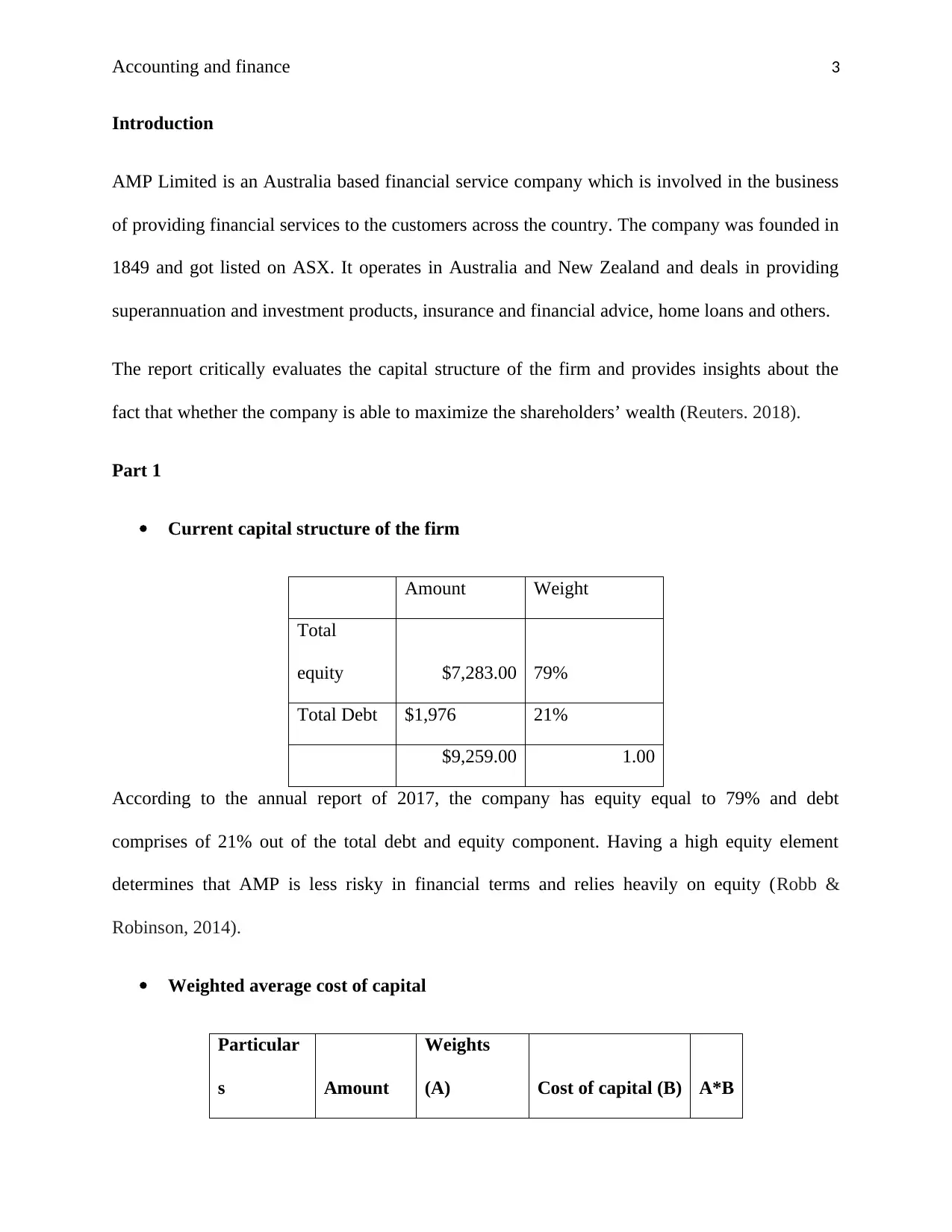
Accounting and finance 3
Introduction
AMP Limited is an Australia based financial service company which is involved in the business
of providing financial services to the customers across the country. The company was founded in
1849 and got listed on ASX. It operates in Australia and New Zealand and deals in providing
superannuation and investment products, insurance and financial advice, home loans and others.
The report critically evaluates the capital structure of the firm and provides insights about the
fact that whether the company is able to maximize the shareholders’ wealth (Reuters. 2018).
Part 1
Current capital structure of the firm
Amount Weight
Total
equity $7,283.00 79%
Total Debt $1,976 21%
$9,259.00 1.00
According to the annual report of 2017, the company has equity equal to 79% and debt
comprises of 21% out of the total debt and equity component. Having a high equity element
determines that AMP is less risky in financial terms and relies heavily on equity (Robb &
Robinson, 2014).
Weighted average cost of capital
Particular
s Amount
Weights
(A) Cost of capital (B) A*B
Introduction
AMP Limited is an Australia based financial service company which is involved in the business
of providing financial services to the customers across the country. The company was founded in
1849 and got listed on ASX. It operates in Australia and New Zealand and deals in providing
superannuation and investment products, insurance and financial advice, home loans and others.
The report critically evaluates the capital structure of the firm and provides insights about the
fact that whether the company is able to maximize the shareholders’ wealth (Reuters. 2018).
Part 1
Current capital structure of the firm
Amount Weight
Total
equity $7,283.00 79%
Total Debt $1,976 21%
$9,259.00 1.00
According to the annual report of 2017, the company has equity equal to 79% and debt
comprises of 21% out of the total debt and equity component. Having a high equity element
determines that AMP is less risky in financial terms and relies heavily on equity (Robb &
Robinson, 2014).
Weighted average cost of capital
Particular
s Amount
Weights
(A) Cost of capital (B) A*B
⊘ This is a preview!⊘
Do you want full access?
Subscribe today to unlock all pages.

Trusted by 1+ million students worldwide

Accounting and finance 4
Equity $ 7,283.00 0.79 11.12% 9%
Debt $ 1,976.00 0.21 3.28% 1%
Total $ 9,259.00 1.00 10%
WACC is the average cost of the financing used by the companies. Generally, firms finance their
assets through debt and equity only (Huizinga, Voget & Wagner, 2018). Computation of WACC
reveals the interest amount company pay to its security holders to finance its assets. The WACC
of AMP is calculated at 10% which lower than required rate of return. It is interpreted that AMP
has provided low returns to its shareholders as compare to the expected one.
Cost of equity
CAPM is the technique used for calculating cost of equity for the firm. For AMP Limited, the
required rate of return is 11.12%. (refer excel).
Comparing the capital structure
AMP
Limited
Amount Weight
Total equity $7,283.00 79%
Total Debt $1,976 21%
$ 9,259.00 1.00
CBA Bank
Amount Weight
Total equity $3,526.00 72%
Total Debt $1,349 28%
Equity $ 7,283.00 0.79 11.12% 9%
Debt $ 1,976.00 0.21 3.28% 1%
Total $ 9,259.00 1.00 10%
WACC is the average cost of the financing used by the companies. Generally, firms finance their
assets through debt and equity only (Huizinga, Voget & Wagner, 2018). Computation of WACC
reveals the interest amount company pay to its security holders to finance its assets. The WACC
of AMP is calculated at 10% which lower than required rate of return. It is interpreted that AMP
has provided low returns to its shareholders as compare to the expected one.
Cost of equity
CAPM is the technique used for calculating cost of equity for the firm. For AMP Limited, the
required rate of return is 11.12%. (refer excel).
Comparing the capital structure
AMP
Limited
Amount Weight
Total equity $7,283.00 79%
Total Debt $1,976 21%
$ 9,259.00 1.00
CBA Bank
Amount Weight
Total equity $3,526.00 72%
Total Debt $1,349 28%
Paraphrase This Document
Need a fresh take? Get an instant paraphrase of this document with our AI Paraphraser
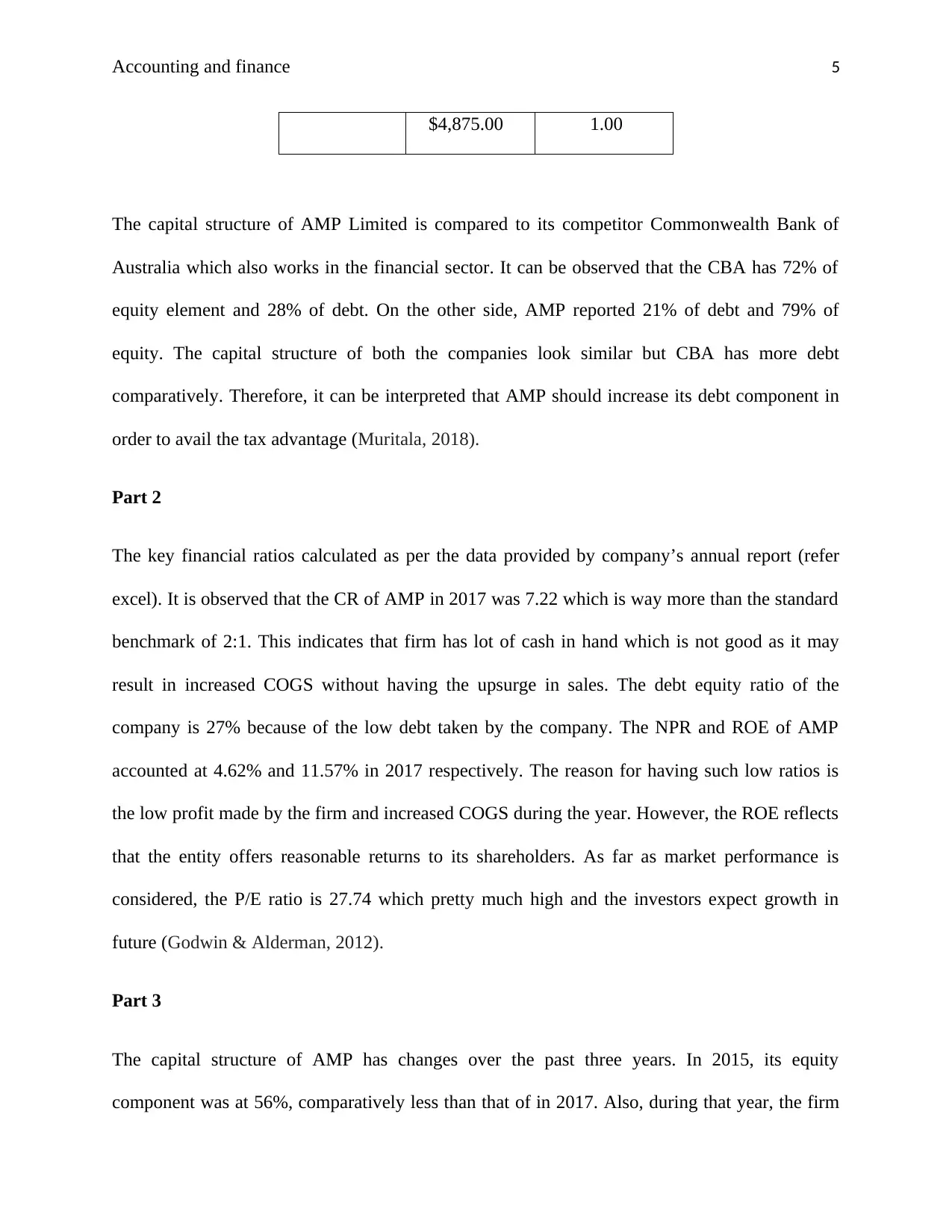
Accounting and finance 5
$4,875.00 1.00
The capital structure of AMP Limited is compared to its competitor Commonwealth Bank of
Australia which also works in the financial sector. It can be observed that the CBA has 72% of
equity element and 28% of debt. On the other side, AMP reported 21% of debt and 79% of
equity. The capital structure of both the companies look similar but CBA has more debt
comparatively. Therefore, it can be interpreted that AMP should increase its debt component in
order to avail the tax advantage (Muritala, 2018).
Part 2
The key financial ratios calculated as per the data provided by company’s annual report (refer
excel). It is observed that the CR of AMP in 2017 was 7.22 which is way more than the standard
benchmark of 2:1. This indicates that firm has lot of cash in hand which is not good as it may
result in increased COGS without having the upsurge in sales. The debt equity ratio of the
company is 27% because of the low debt taken by the company. The NPR and ROE of AMP
accounted at 4.62% and 11.57% in 2017 respectively. The reason for having such low ratios is
the low profit made by the firm and increased COGS during the year. However, the ROE reflects
that the entity offers reasonable returns to its shareholders. As far as market performance is
considered, the P/E ratio is 27.74 which pretty much high and the investors expect growth in
future (Godwin & Alderman, 2012).
Part 3
The capital structure of AMP has changes over the past three years. In 2015, its equity
component was at 56%, comparatively less than that of in 2017. Also, during that year, the firm
$4,875.00 1.00
The capital structure of AMP Limited is compared to its competitor Commonwealth Bank of
Australia which also works in the financial sector. It can be observed that the CBA has 72% of
equity element and 28% of debt. On the other side, AMP reported 21% of debt and 79% of
equity. The capital structure of both the companies look similar but CBA has more debt
comparatively. Therefore, it can be interpreted that AMP should increase its debt component in
order to avail the tax advantage (Muritala, 2018).
Part 2
The key financial ratios calculated as per the data provided by company’s annual report (refer
excel). It is observed that the CR of AMP in 2017 was 7.22 which is way more than the standard
benchmark of 2:1. This indicates that firm has lot of cash in hand which is not good as it may
result in increased COGS without having the upsurge in sales. The debt equity ratio of the
company is 27% because of the low debt taken by the company. The NPR and ROE of AMP
accounted at 4.62% and 11.57% in 2017 respectively. The reason for having such low ratios is
the low profit made by the firm and increased COGS during the year. However, the ROE reflects
that the entity offers reasonable returns to its shareholders. As far as market performance is
considered, the P/E ratio is 27.74 which pretty much high and the investors expect growth in
future (Godwin & Alderman, 2012).
Part 3
The capital structure of AMP has changes over the past three years. In 2015, its equity
component was at 56%, comparatively less than that of in 2017. Also, during that year, the firm
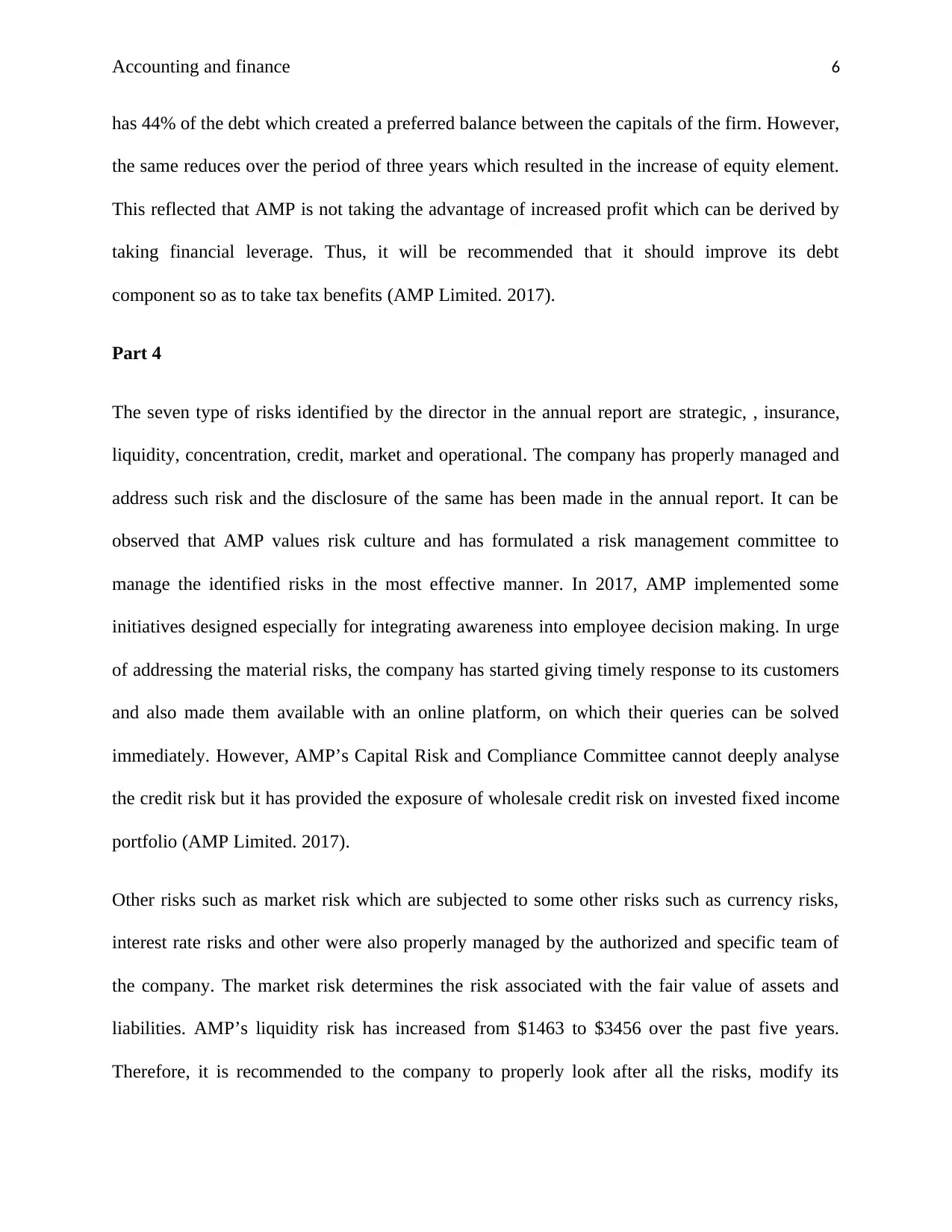
Accounting and finance 6
has 44% of the debt which created a preferred balance between the capitals of the firm. However,
the same reduces over the period of three years which resulted in the increase of equity element.
This reflected that AMP is not taking the advantage of increased profit which can be derived by
taking financial leverage. Thus, it will be recommended that it should improve its debt
component so as to take tax benefits (AMP Limited. 2017).
Part 4
The seven type of risks identified by the director in the annual report are strategic, , insurance,
liquidity, concentration, credit, market and operational. The company has properly managed and
address such risk and the disclosure of the same has been made in the annual report. It can be
observed that AMP values risk culture and has formulated a risk management committee to
manage the identified risks in the most effective manner. In 2017, AMP implemented some
initiatives designed especially for integrating awareness into employee decision making. In urge
of addressing the material risks, the company has started giving timely response to its customers
and also made them available with an online platform, on which their queries can be solved
immediately. However, AMP’s Capital Risk and Compliance Committee cannot deeply analyse
the credit risk but it has provided the exposure of wholesale credit risk on invested fixed income
portfolio (AMP Limited. 2017).
Other risks such as market risk which are subjected to some other risks such as currency risks,
interest rate risks and other were also properly managed by the authorized and specific team of
the company. The market risk determines the risk associated with the fair value of assets and
liabilities. AMP’s liquidity risk has increased from $1463 to $3456 over the past five years.
Therefore, it is recommended to the company to properly look after all the risks, modify its
has 44% of the debt which created a preferred balance between the capitals of the firm. However,
the same reduces over the period of three years which resulted in the increase of equity element.
This reflected that AMP is not taking the advantage of increased profit which can be derived by
taking financial leverage. Thus, it will be recommended that it should improve its debt
component so as to take tax benefits (AMP Limited. 2017).
Part 4
The seven type of risks identified by the director in the annual report are strategic, , insurance,
liquidity, concentration, credit, market and operational. The company has properly managed and
address such risk and the disclosure of the same has been made in the annual report. It can be
observed that AMP values risk culture and has formulated a risk management committee to
manage the identified risks in the most effective manner. In 2017, AMP implemented some
initiatives designed especially for integrating awareness into employee decision making. In urge
of addressing the material risks, the company has started giving timely response to its customers
and also made them available with an online platform, on which their queries can be solved
immediately. However, AMP’s Capital Risk and Compliance Committee cannot deeply analyse
the credit risk but it has provided the exposure of wholesale credit risk on invested fixed income
portfolio (AMP Limited. 2017).
Other risks such as market risk which are subjected to some other risks such as currency risks,
interest rate risks and other were also properly managed by the authorized and specific team of
the company. The market risk determines the risk associated with the fair value of assets and
liabilities. AMP’s liquidity risk has increased from $1463 to $3456 over the past five years.
Therefore, it is recommended to the company to properly look after all the risks, modify its
⊘ This is a preview!⊘
Do you want full access?
Subscribe today to unlock all pages.

Trusted by 1+ million students worldwide
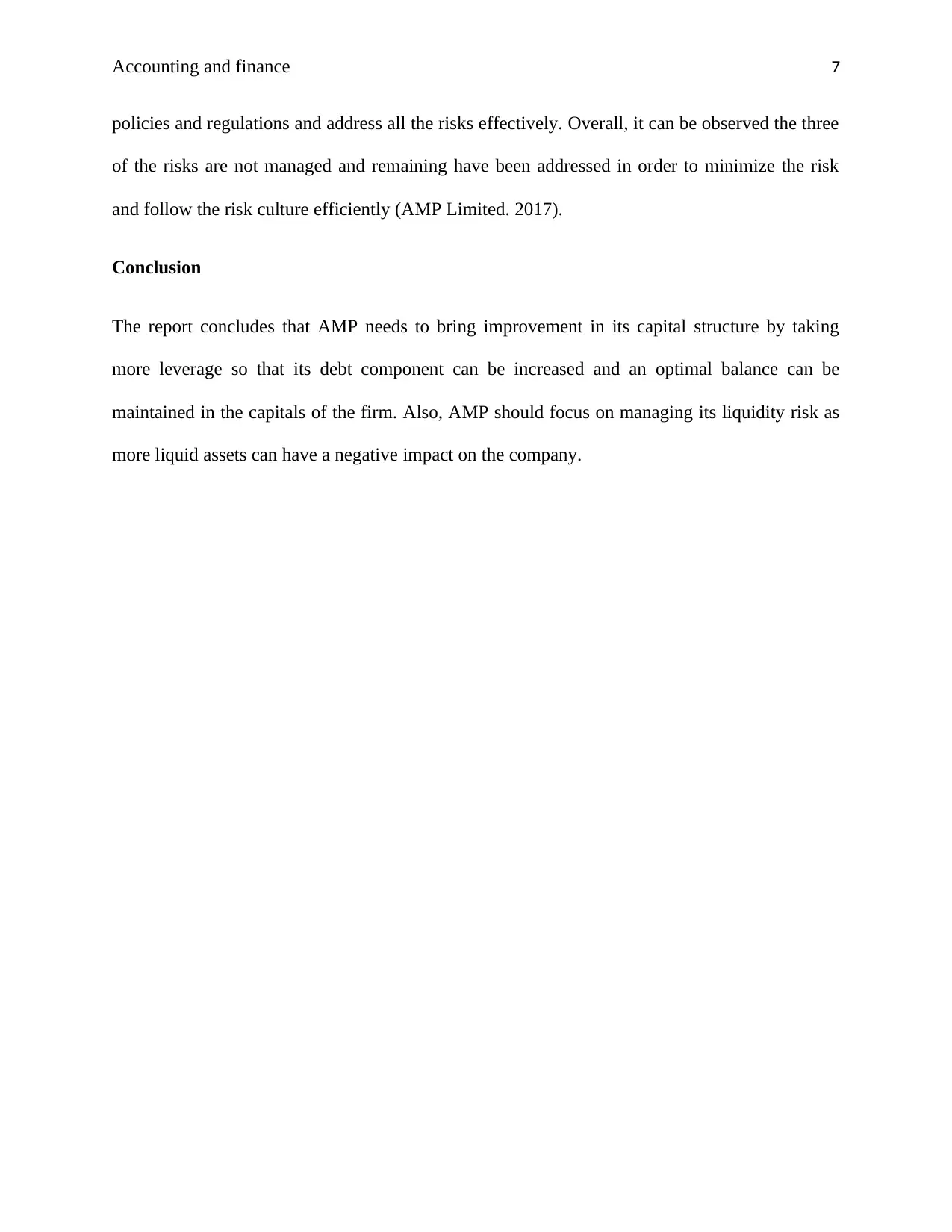
Accounting and finance 7
policies and regulations and address all the risks effectively. Overall, it can be observed the three
of the risks are not managed and remaining have been addressed in order to minimize the risk
and follow the risk culture efficiently (AMP Limited. 2017).
Conclusion
The report concludes that AMP needs to bring improvement in its capital structure by taking
more leverage so that its debt component can be increased and an optimal balance can be
maintained in the capitals of the firm. Also, AMP should focus on managing its liquidity risk as
more liquid assets can have a negative impact on the company.
policies and regulations and address all the risks effectively. Overall, it can be observed the three
of the risks are not managed and remaining have been addressed in order to minimize the risk
and follow the risk culture efficiently (AMP Limited. 2017).
Conclusion
The report concludes that AMP needs to bring improvement in its capital structure by taking
more leverage so that its debt component can be increased and an optimal balance can be
maintained in the capitals of the firm. Also, AMP should focus on managing its liquidity risk as
more liquid assets can have a negative impact on the company.
Paraphrase This Document
Need a fresh take? Get an instant paraphrase of this document with our AI Paraphraser
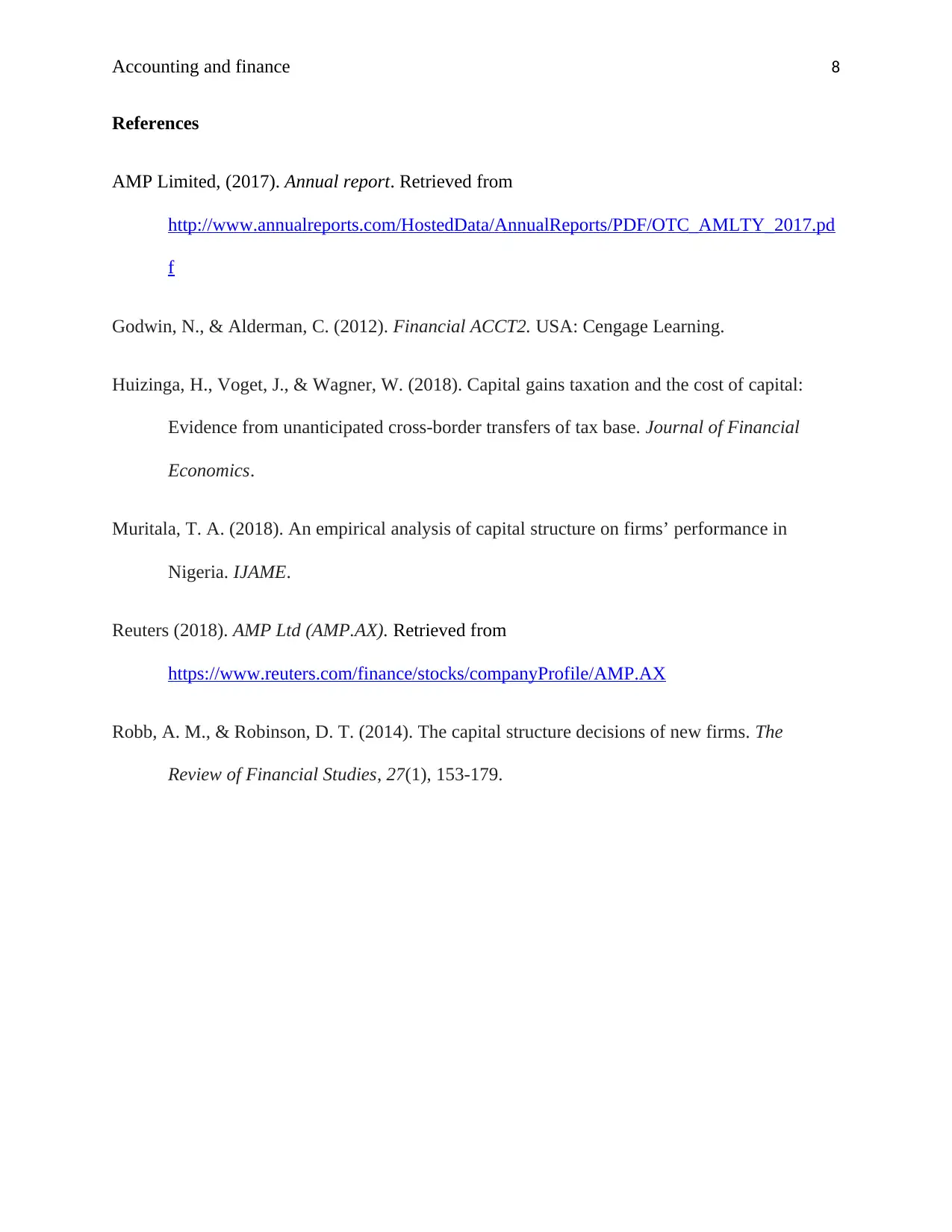
Accounting and finance 8
References
AMP Limited, (2017). Annual report. Retrieved from
http://www.annualreports.com/HostedData/AnnualReports/PDF/OTC_AMLTY_2017.pd
f
Godwin, N., & Alderman, C. (2012). Financial ACCT2. USA: Cengage Learning.
Huizinga, H., Voget, J., & Wagner, W. (2018). Capital gains taxation and the cost of capital:
Evidence from unanticipated cross-border transfers of tax base. Journal of Financial
Economics.
Muritala, T. A. (2018). An empirical analysis of capital structure on firms’ performance in
Nigeria. IJAME.
Reuters (2018). AMP Ltd (AMP.AX). Retrieved from
https://www.reuters.com/finance/stocks/companyProfile/AMP.AX
Robb, A. M., & Robinson, D. T. (2014). The capital structure decisions of new firms. The
Review of Financial Studies, 27(1), 153-179.
References
AMP Limited, (2017). Annual report. Retrieved from
http://www.annualreports.com/HostedData/AnnualReports/PDF/OTC_AMLTY_2017.pd
f
Godwin, N., & Alderman, C. (2012). Financial ACCT2. USA: Cengage Learning.
Huizinga, H., Voget, J., & Wagner, W. (2018). Capital gains taxation and the cost of capital:
Evidence from unanticipated cross-border transfers of tax base. Journal of Financial
Economics.
Muritala, T. A. (2018). An empirical analysis of capital structure on firms’ performance in
Nigeria. IJAME.
Reuters (2018). AMP Ltd (AMP.AX). Retrieved from
https://www.reuters.com/finance/stocks/companyProfile/AMP.AX
Robb, A. M., & Robinson, D. T. (2014). The capital structure decisions of new firms. The
Review of Financial Studies, 27(1), 153-179.
1 out of 8
Related Documents
Your All-in-One AI-Powered Toolkit for Academic Success.
+13062052269
info@desklib.com
Available 24*7 on WhatsApp / Email
![[object Object]](/_next/static/media/star-bottom.7253800d.svg)
Unlock your academic potential
Copyright © 2020–2025 A2Z Services. All Rights Reserved. Developed and managed by ZUCOL.





